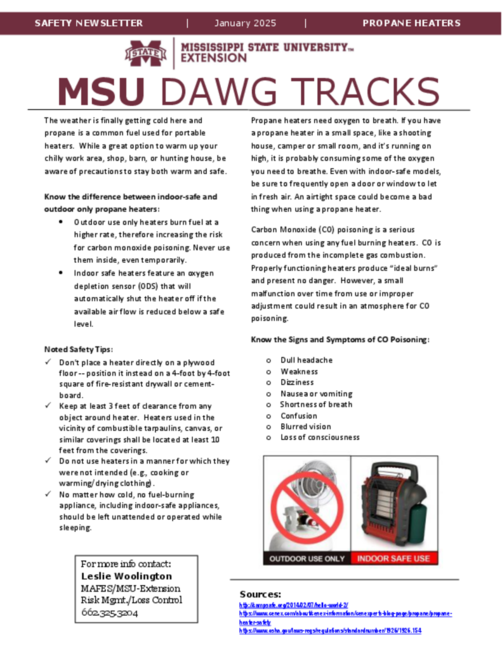Dawg Tracks Safety Talk
Propane Heaters
The weather is finally getting cold here and propane is a common fuel used for portable heaters. While a great option to warm up your chilly work area, shop, barn, or hunting house, be aware of precautions to stay both warm and safe.
Know the difference between indoor-safe and outdoor only propane heaters:
- Outdoor use only heaters burn fuel at a higher rate, therefore increasing the risk for carbon monoxide poisoning. Never use them inside, even temporarily.
- Indoor safe heaters feature an oxygen depletion sensor (ODS) that will automatically shut the heater off if the available air flow is reduced below a safe level.
Noted Safety Tips:
- Don't place a heater directly on a plywood floor -- position it instead on a 4-foot by 4-foot square of fire-resistant drywall or cement-board.
- Keep at least 3 feet of clearance from any object around heater. Heaters used in the vicinity of combustible tarpaulins, canvas, or similar coverings shall be located at least 10 feet from the coverings.
- Do not use heaters in a manner for which they were not intended (e.g., cooking or warming/drying clothing).
- No matter how cold, no fuel-burning appliance, including indoor-safe appliances, should be left unattended or operated while sleeping.
Propane heaters need oxygen to breath. If you have a propane heater in a small space, like a shooting house, camper or small room, and it’s running on high, it is probably consuming some of the oxygen you need to breathe. Even with indoor-safe models, be sure to frequently open a door or window to let in fresh air. An airtight space could become a bad thing when using a propane heater.
Carbon Monoxide (CO) poisoning is a serious concern when using any fuel burning heaters. CO is produced from the incomplete gas combustion. Properly functioning heaters produce “ideal burns” and present no danger. However, a small malfunction over time from use or improper adjustment could result in an atmosphere for CO poisoning.
Know the Signs and Symptoms of CO Poisoning:
- Dull headache
- Weakness
- Dizziness
- Nausea or vomiting
- Shortness of breath
- Confusion
- Blurred vision
- Loss of consciousness
Sources:
http://campsafe.org/2014/02/07/hello-world-2/
https://www.cenex.com/about/cenex-information/cenexperts-blog-page/propane/propaneheater-safety
https://www.osha.gov/laws-regs/regulations/standardnumber/1926/1926.154
